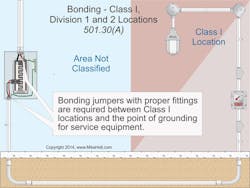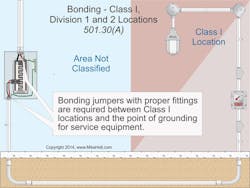All questions and answers are based on the 2014 NEC.
Q. What are the grounding and bonding requirements for Class I locations?
A. Because of the explosive conditions associated with electrical installations in hazardous (classified) locations [500.5], electrical continuity of metal parts of equipment and raceways must be ensured — regardless of the voltage of the circuit.
Locknuts aren’t suitable for bonding purposes in hazardous (classified) locations; thus bonding jumpers or other approved means of bonding must be used. Such means of bonding apply to all intervening raceways, fittings, boxes, enclosures, etc. between Class I locations and service equipment [501.30] (Figure).
Regardless of the circuit voltage, electrical continuity of metal parts of equipment and raceways in hazardous (classified) locations must be ensured by bonding-type locknuts, bushings, wedges, or bushings with bonding jumpers [250.92(B)(4)]; whether or not equipment grounding conductors of the wire type are installed in the raceway [250.100].
A separate equipment grounding conductor isn’t required if a metal raceway is used for equipment grounding. Threaded couplings and hubs made up wrenchtight provide a suitable low impedance path [250.100].
Flexible metal conduit and liquidtight flexible metal conduit must have an equipment bonding jumper of the wire type installed in accordance with Sec. 250.102. Bonding jumpers are sized in accordance with Table 250.122, based on the rating of the overcurrent device [250.102(D)], and where installed outside of a raceway, the length of bonding jumpers must not exceed 6 ft — and they must be routed with the raceway [250.102(E)(2)].
Q. What are the NEC requirements for sizing raceways?
A. Raceways must be large enough to permit the installation and removal of conductors without damaging the conductor’s insulation [300.17]. When all conductors in a raceway are the same size and of the same insulation type, the number of conductors permitted can be determined by Annex C. When different size conductors are installed in a raceway, conductor fill is limited to the percentages shown in Table 1 of Chapter 9.
The above percentages are based on conditions where the length of the conductor and number of raceway bends are within reasonable limits [Chapter 9, Table 1, Note 1].
When sizing a raceway, first determine the total area of conductors (Chapter 9, Table 5 for insulated conductors and Chapter 9, Table 8 for bare conductors). Then, select the raceway from Chapter 9, Table 4, in accordance with the percent fill listed in Chapter 9, Table 1.
Let’s run through an example problem to make sure you understand the concepts noted above.
Question: What trade size Schedule 40 PVC conduit is required for the following conductors: three 500 THHN, one 250 THHN, and one 3 THHN?
Step 1: Determine the total area of conductors [Chapter 9, Table 5]:
500 THHN — 0.7073 × 3 = 2.1219 in.2
250 THHN — 0.3970 × 1 = 0.3970 in.2
3 THHN — 0.0973 × 1 = 0.0973 in.2
Total area = 2.6162 in.2
Step 2: Select the raceway at 40% fill [Chapter 9, Table 4].
A trade size 3, Schedule 40 PVC = 2.907 in.2 of conductor fill at 40%.
About the Author

Mike Holt
Mike Holt is the owner of Mike Holt Enterprises (www.MikeHolt.com), one of the largest electrical publishers in the United States. He earned a master's degree in the Business Administration Program (MBA) from the University of Miami. He earned his reputation as a National Electrical Code (NEC) expert by working his way up through the electrical trade. Formally a construction editor for two different trade publications, Mike started his career as an apprentice electrician and eventually became a master electrician, an electrical inspector, a contractor, and an educator. Mike has taught more than 1,000 classes on 30 different electrical-related subjects — ranging from alarm installations to exam preparation and voltage drop calculations. He continues to produce seminars, videos, books, and online training for the trade as well as contribute monthly Code content to EC&M magazine.

